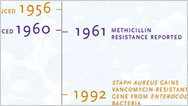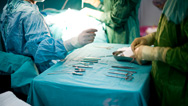Killer Microbe
- Posted 07.09.08
- NOVA scienceNOW
(This program is no longer available for online streaming.) Along with all the problems that war brings, we're now facing a new enemy invader emerging from Iraq. Its soldiers are packing weapons, dozens of them. They can survive for weeks at a time without food or water, and we don't know how to fight them. As correspondent John Torres reports, what we really need is a good biologist.
Why? Because the new threat comes in the form of a tiny microbe, a bacterium called baumannii. Known in Iraq as "Iraqibacter," it is named for microbiologist Paul Baumann, who researched it in the 1960s. But even he couldn't predict what this tiny, single-celled organism would one day become, namely, a drug-resistant killer. How to stop it?
Transcript
Killer Microbe
PBS Air date: July 9, 2008
NEIL DeGRASSE TYSON: :Along with all the problems that war brings, we're now facing a new enemy invader, emerging from Iraq. Each of its soldiers are packing weapons, dozens of them. These guys can survive for weeks at a time without food or water. We don't know how to fight them, but we've got to find out. Guns and tanks won't help us here.
But as correspondent John Torres reports, what we really need is a good biologist.
JOHN TORRES (Correspondent): There's a killer on the battle-torn streets of Iraq. But it doesn't carry a gun. It's attacking injured soldiers. With better armor and advanced medical care, they're surviving in larger numbers than ever before.
I was a doctor in Iraq, with the Air National Guard, and I can tell you from first-hand experience, the survival rate for wounded soldiers, it's a remarkable story. But it's one with a downside.
That downside comes in the form of a tiny microbe with a powerful punch. Here's the culprit. It's a bacterium called baumannii, referred to in Iraq as Iraqibacter. It's named for microbiologist Paul Baumann, who researched it back in 1968. But even he couldn't predict what this tiny, single-celled organism would one day become.
Like most bacteria, it lives in colonies and is constantly reproducing simply by dividing and dividing again. A single bacterium can give rise to five billion trillion in only a day.
This bug used to be relatively harmless, yet somehow it's found a way to transform itself into a drug-resistant killer.
One of its many victims was ABC news correspondent Bob Woodruff. On January 29th, 2006, while embedded with the U.S. 4th Infantry division in Baghdad, his vehicle was hit by a roadside bomb. To keep him alive, doctors had to remove part of his skull and induce a medical coma. Miraculously, Bob was stabilized and evacuated to Bethesda Naval Hospital, in Maryland.
His wife, Lee, was there, by his side.
:What was going on with Bob, at that point?
LEE WOODRUFF: (Co-author, In an Instant): He underwent many different surgeries for different things, but I think that's the point at which they became nervous about pneumonia and sepsis setting in. And in fact, that was what had happened.
JOHN TORRES: :A baumannii infection had spread throughout his body, and he was back at death's door.
LEE WOODRUFF: :It seemed impossible to me that someone could be in a war and be hit by a bomb and survive this and then be, actually, felled, by a simple bacteria in a hospital.
JOHN TORRES: :Bob Woodruff is just one of many soldiers and civilians picking up this deadly microbe, in hospitals along the evacuation chain out of Iraq, and bringing it back home to America, where it's infecting even people who have never seen a battlefield.
MICHAEL G. SMITH :(Invitrogen Corporation): It has this ability to hang around in places where it ought not, like on doorknobs and pillow cases and the like.
JOHN TORRES: :...where it can it can survive for weeks. So why not simply use an antibiotic, like penicillin, to fight it? After all, haven't antibiotics been the magic bullet, saving soldiers' lives, since World War II?
MIKE SMITH: :We saved a lot of people's lives. Penicillin was a wonder drug.
JOHN TORRES: :But something has changed. Now the bugs are fighting back. Microbiologist Mike Smith demonstrates how drug resistant this bug has become.
MIKE SMITH: :You take baumanii and you put it on a plate containing imipenem.
JOHN TORRES: :He places colonies, containing millions of bacteria, in several petri dishes and confronts them with imipenem, an antibiotic so strong it's nicknamed gorillacillin. After 12 hours, all the bacteria should be dead, but they're not.
MIKE SMITH: :Unfortunately, this is the kind of thing we're seeing, where certain colonies are surviving. In this case, you can see a few in the middle there.
JOHN TORRES: :Now, looking at it...there's only six or eight little colonies.
MIKE SMITH: :These are the only ones that are living, so the entire population, now, of remaining bacteria, are imipenem-resistant.
JOHN TORRES: :Smith and graduate student Tara Gianoulis prepare a sample of baumannii. Its D.N.A. will be sequenced, one letter at a time. The results reveal that baumannii has large sections of genes that don't belong, foreign genes that are giving it resistance to antibiotics.
MIKE SMITH: :There is a multi-drug-resistant strain that took 45 different drug-resistance genes and stuck them in one spot. This should be alarming, because that's what this bug can do.
JOHN TORRES: :How is this possible?
There's only one way we get our genes, and that's from our parents. It's called vertical gene transfer. But it turns out bacteria can also get genes in a process called horizontal gene transfer. One way that happens is when two bacteria get together for a little friendly conjugation—the microbial form of snuggling—they form a connection and squirt D.N.A. into each other.
Turns out, baumannii has been getting a little too friendly. Could that be what's making it so nasty?
To find out, Mike Smith zaps a colony of baumannii with electricity, creating over 1,000 mutant bugs: each one different, each one missing one known gene. He takes these mutant microbes and feeds them to some microscopic worms.
MIKE SMITH: :They're an amazing little organism.
JOHN TORRES: :For Mike, one of the best things about these worms is that they love eating bacteria.
MIKE SMITH: :That's what it eats for breakfast, lunch and dinner. And it turns out that when these worms eat disease-causing bacteria, it often kills them, too.
JOHN TORRES: :Just like lethal bacteria can kill us.
But if Mike has succeeded in zapping out the lethal genes, then some of his worms should survive. Will it work? He'll find out at dinnertime.
The worms that survive give Mike the information that he needs to know who baumanii has been getting friendly with.
It turns out one of the deadly genes comes from a well-known killer, the bacteria responsible for Legionnaire's disease, a deadly bug first recognized, back in 1976, when, at an American Legion convention, over 1,000 people suddenly came down with a serious lung infection. Thirty-four died.
MIKE SMITH: :It's taking in drug resistance gene, and it's developing drug resistance. It's taking in virulence, or disease-causing-type genes, and it's using them.
JOHN TORRES: :With the addition of some new genes, baumannii becomes more lethal and harder to defeat, all at the same time. It's an ongoing battle, not easily won.
MIKE SMITH: :Perhaps instead of trying to just overwhelm them and kill them, maybe we can coerce them into doing something that they weren't thinking about doing, if we understand how they communicate.
JOHN TORRES: :But bacteria have been around a lot longer than we have, and they are very good at adapting to anything that we throw at them. So, for now, it's a matter of early intervention, better hospital hygiene and good medical care. That's what saved Bob Woodruff.
LEE WOODRUFF: :He's had, I think, a miraculous recovery. It's pretty phenomenal. It speaks to the acute medical care that he got at the beginning, as well.
Credits
- Edited by
- Jed Rauscher
- Produced by
- Emily Bernhard
- Directed by
- Terri Randall
- Executive Producer
- Samuel Fine
- Executive Editor
- Neil deGrasse Tyson
- Senior Series Producer
- Vincent Liota
- Supervising Producers
-
Stephen Sweigart
Joey David - Editorial Producer
- Julia Cort
- Development Producer
- Vinita Mehta
- Senior Editor
- David Chmura
- Online Editor
- Laura Raimondo
- Series Production Assistant
- Fran Laks
- Assistant Editors
-
Susan Perla
Tung-Jen (Sunny) Chiang - Compositors
-
Brian Edgerton
Yunsik Noh
Tristian Goik - Music
- Rob Morsberger
- NOVA scienceNOW Series Animation
- Edgeworx
- Associate Producers
-
Melanie Cunningham
Jeff Marion
Steven Reich - Camera
-
Chad Baron
Joseph Brunette
Mark Carroll
Joseph Friedman
Sean Glenn
Mark Gunning
Jerry Hattan
Edward Marritz
Michael D. McClare - Sound Recordists
-
Chad Baron
Tom Eichler
Dennis Hrbek
Charlie Maccarone
Janice Mahan
Mark Mandler
Pete Nenortas
JR Rodriguez
Paul Rusnak
Dennis Sprankel
Robert Sullivan
John van der Does - Sound Mix
- David Chmura
- Animation
-
Brian Edgerton
Sputnik Animation
James LaPlante - Production Assistants
-
Daniel Sites
Elizabeth Stachow
Bobby Tucker - For Lone Wolf Documentary Group
-
- Executive Producer
- Kirk Wolfinger
- Production Manager
- Donna Huttemann
- Archival Material
-
American Broadcasting Companies
BBC
Larry Burrows Estate
Janice Carr
Wade B. Clark Jr.
Corbis
Friedman Archives
ITN
Utako Kikutani
NASA
National Geographic
NewspaperArchive.Com
NIAID/RML
Streamline Films
Adam Zoghlin, Timelapse.com - Special Thanks
-
Comunidad Inti Wara Yassi
Tim Endy, MD
Goddard Space Flight Center
Gerard Irzyk, PhD, 454 Life Sciences
Meena Hartenstein
Lance Corporal Tim Lang
Nicholas Ornston, PhD
Penn State University
The Crew of SM-4
Walter Reed Army Medical Center
Eric Sargis
Michael Snyder, PhD
The Snyder Lab, Yale University
Arjun Srinivasan, MD
University of Florida
Bob and Lee Woodruff
Glenn Wortmann, MD
Yale University - Neil deGrasse Tyson
- is director of the Hayden Planetarium in the Rose Center for Earth and Space at the American Museum of Natural History.
- NOVA scienceNOW Consortium Stations
-
Nebraska Educational Telecommunications, NET
Public Broadcasting for Northern California, KQED
Twin Cities Public Television, TPT
Wisconsin Public Television, WPT - NOVA Series Graphics
- yU + co.
- NOVA Theme Music
-
Walter Werzowa
John Luker
Musikvergnuegen, Inc. - Additional NOVA Theme Music
-
Ray Loring
Rob Morsberger - Post Production Online Editor
- Spencer Gentry
- Closed Captioning
- The Caption Center
- Publicity
-
Carole McFall
Eileen Campion
Lindsay de la Rigaudiere
Victoria Louie
Kate Becker - Senior Researcher
- Gaia Remerowski
- Production Coordinator
- Linda Callahan
- Paralegals
-
Raphael Nemes
Sarah Erlandson - Talent Relations
-
Scott Kardel, Esq.
Janice Flood - Legal Counsel
- Susan Rosen
- Post Production Assistant
- Darcy Forlenza
- Associate Producer, Post Production
- Patrick Carey
- Post Production Supervisor
- Regina O'Toole
- Post Production Editors
-
Rebecca Nieto
Alex Kreuter - Post Production Manager
- Nathan Gunner
- Compliance Manager
- Linzy Emery
- Business Manager
- Joseph P. Tracy
- Producers, Special Projects
-
Lisa Mirowitz
David Condon - Coordinating Producer
- Laurie Cahalane
- Senior Science Editor
- Evan Hadingham
- Senior Series Producer
- Melanie Wallace
- Managing Director
- Alan Ritsko
- Senior Executive Producer
- Paula S. Apsell
This material is based upon work supported by the National Science Foundation under Grant No. 0638931. Any opinions, findings, and conclusions or recommendations expressed in this material are those of the author(s) and do not necessarily reflect the views of the National Science Foundation.
NOVA scienceNOW is a trademark of the WGBH Educational Foundation
NOVA scienceNOW is produced for WGBH/Boston by NOVA
© 2008 WGBH Educational Foundation
All rights reserved
- Image credit: (cells) Courtesy Tara Gianoulis and Whitman Schofield
Participants
- Jonathan Bloch
- Florida Museum of Natural History www.flmnh.ufl.edu/directory/cvs/jbloch_cv.htm
- Michael G. Smith
- Invitrogen Corporation www.invitrogen.com/site/us/en/home.html
- John Torres
- Correspondent
- Lee Woodruff
- Coauthor, In an Instant
Related Links
-

Killer Microbe: Expert Q&A
Microbiologist Mike Smith answers questions about Iraqibacter and multidrug-resistant pathogens in general.
-

Arms Race With a Superbug
Certain microbes evolve defenses against every antibiotic we throw at them. Staph aureus is a sobering case in point.
-

Manipulating Hospitals' Microbes
Hospitals are designed to minimize specific pathogens, but soon we may manipulate a building's entire microbiome.
-

Killer Microbe
Learn how biotechnology is used to analyze the evolution of a harmless bacterium into a highly drug-resistant pathogen.



